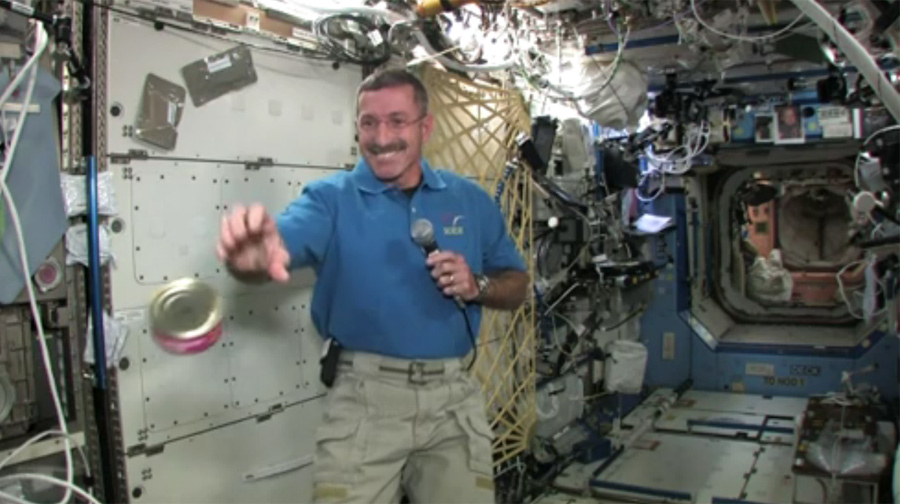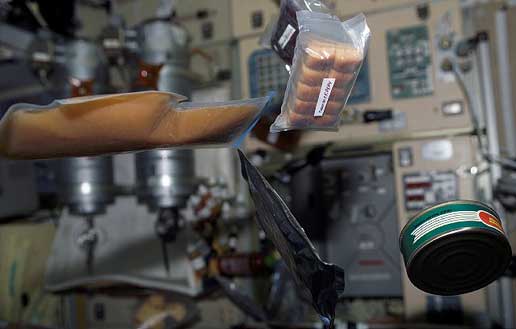Thanksgiving in Space: Playing With Food Allowed

A light Thanksgiving dinner doesn't necessarily mean skimping on the turkey or stuffing, not even aboard the International Space Station. The three crew members, who arrived just in time to spend a weightless holiday in orbit, will enjoy a feast of irradiated smoked turkey and heat-treated yams while floating 220 miles (354 kilometers) above Earth tomorrow (Nov. 24).
The weightless feast will include traditional favorites with a space-y twist, such as NASA's own cornbread dressing, home-style potatoes, cranberries, and for dessert — drum roll! — cherry-blueberry cobbler, served in a space pouch.
Around the table will be NASA astronaut Dan Burbank and Russian cosmonauts Anton Shkaplerov and Anatoly Ivanishin. The trio arrived at the space station Tuesday (Nov. 22), and they are scheduled to live and work aboard the outpost until March. Their time will be spent conducting experiments and preparing for the arrival of new commercial cargo-carrying spacecraft.
Burbank recently described the crew's Thanksgiving plans in a NASA holiday video message, with Burbank catching floating food packages as he gave Earthlings a rundown of the Thursday menu. [A Gallery of Space Food]
The one important missing ingredient? Family.
"We're going to be missing the family and friends back home; we're going to hopefully get a chance to talk to them," Burbank said.
Even so, the astronaut has a lot on his gratitude list.

"We're going to enjoy some great food, we're going to enjoy a view of planet Earth from here, we're going to be real thankful for the opportunity that we have to fly aboard this magnificent space station, and we're going to be thankful for the love and support of all the folks that we have back home," Burbank said.
Get the Space.com Newsletter
Breaking space news, the latest updates on rocket launches, skywatching events and more!
Even though the crew members won't be able to bow their heads in thanks with their families and friends, the feast will provide a reminder of home. "The food we eat in space tastes very much like the food we enjoy on Earth," a former space station occupant, NASA astronaut Clay Anderson, said from the ground.
The trickiest part of preparing a space Thanksgiving meal has to do with shelf life: Without any food refrigerators or freezers on the space station, food must last in room temperature for long periods of time, said NASA food scientist Vickie Kloeris, manager of the space station's food system. That's why they freeze-dry and thermostabilize the foods. Thermostabilizing involves pre-heating the food to kill bacteria.
Outdoing a meal with family and friends may be difficult, but the space station has something Grandma's house doesn't, and that's microgravity.
"It's totally legal to play with your food in outer space," Anderson told SPACE.com, adding that astronauts can spin the floating food on their spoon, which is "great fun." And Anderson would know. He spent 152 days living aboard the station in 2007, returning to the outpost in 2010 as a member of space shuttle mission STS-131.
During his stays, he said, he ate all of the foods being served at Thanksgiving, though he wasn't on the station for turkey day or Christmas in space.
The astronauts may wind up in the same turkey coma as people on Earth. Anderson said that even in microgravity it's tempting to stuff yourself. "I ate like a pig when I was there," he said, "and I still lost weight."
Follow SPACE.com for the latest in space science and exploration news on Twitter @Spacedotcomand on Facebook.
Join our Space Forums to keep talking space on the latest missions, night sky and more! And if you have a news tip, correction or comment, let us know at: community@space.com.










